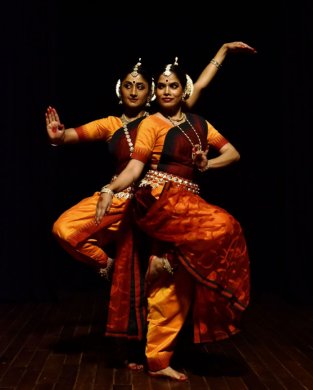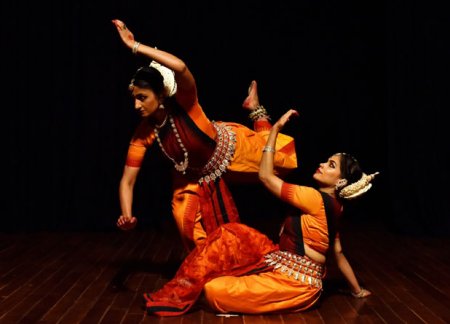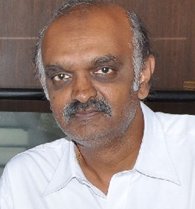
|   |

|   |
Ekam-An enchanting duet - G Ulaganathan e-mail: ulag_nath@yahoo.com Photos: Akila Venkat April 2, 2021 After nearly a year during which one was bombarded with all kinds of dance performances online, it was a big relief to step into the beautiful amphi-theatre Jagriti in Bangalore on March 21. The evening of enchanting Odissi dance was by Madhulita Mohapatra and her senior disciple Sahana Raghavendra Maiya. Called Ekam, or return to oneness, the dancers exuded grace and with the natural fluid grace and the natural lyrical beauty of Odissi dance, they explored longing and merger of the individual soul (the human) with the original source, the supreme soul (the God), as propounded by the popular Advaita philosophy of monism. Both the pretty dancers have been together for many years now and are able to read each other's body language well. So it was an interesting duel where many emotions were brought out with telling impact.  In the opening number, the Ardhanarishwara, it was the familiar tale of the half-father, Shiva and half-mother, Parvati and the merger of the supreme consciousness (Shiva) and divine energy (Shakti). Shiva (Purusha) is the Being (the source of creation) and Parvati (Prakriti) is the Becoming (the nature or the creation). They both brilliantly interpreted the Ardhanarishwara Stotram by Adi Shankaracharya. Originally choreographed by Guru Kelucharan Mohapatra, the complex item had soul stirring music by Pt. Raghunath Panigrahi. Next came another masterly piece by Kelubabu, "Chandana Charchita," an ashtapadi from Geeta Govinda. Human plurality submerges in the delightful embrace of divine Unity… is the symbolism of Krishna's Raasleela with gopis. Krishna is the supreme Unity and the gopis are various parts of this unity and after a session of hide and seek, they finally surrender and merge with this unity. Sahana and Madhulita played multiple roles as gopis and Krishna. The gopis of Vrindavan are mesmerised by the beauty of Krishna. Clad in the yellow silk robe, his black body is bedecked with sandal paste and garlanded with tulsi leaves and flowers. The melodious musical score by the brilliant Pt. Bhubaneswar Mishra with the predominance of flute and spells of silence was a beauty in itself. "Dui deha ame..." revealed the metaphysical state of love as stated in Brihadaranyaka Upanishad, "In the embrace of his beloved, the lover forgets the whole world, everything both within and without." It is when forever ceases to be just a word and becomes this , says the lovely lyric which goes on to say when two souls merge with a single thought, two hearts beat as one. Kedar Mishra's soulful lyric combined with musical score by Sukanta Kundu was the highlight of this piece. Then came the ever popular "Yahi Madhava" with vintage choreography by guru Debaprasad Das. Guru Ramhari Das's musical score set to Bhairavi raag gave life to the brilliant exposition of the Krishna -Radha romance with both dancers effectively conveying the passionate love combined with the bhakti with interplay of anger and various other rasas. Madly in love with Krishna and believing that his love was only for her, Krishna's infidelity, his dalliance with other gopis, pains Radha. She is eagerly waiting all night long for Krishna's arrival, but Krishna hasn't come. When he finally arrives the next morning, there are marks of love play with another woman and his body bears her nail marks, lips are tinged black kissing her kohl eyes. The pain and care, with which she had decorated herself, for him, are useless without him. As Krishna pretends to leave her, Radha's pain turns out to be a deep disappointment and anger. Radha cannot believe that Krishna can leave her like this. "Yahi Madhava, Yahi Keshava, maa vada kaitava vaadam." Madhulita as Radha and Sahana as Krishna were brilliant in presenting this ever favourite number.  The final item, Radha Vadana was about 'Jiva Brahma Aikya Vedanta Rahasyam' (Union of the individual soul with the Universal soul). Radha Vadana from Geeta Govinda was presented with music by Subas Pani, rhythm composition by Bijaya Kumar Barik and Dhaneswar Swain. This was an excellent choreographic work by Madhulita's guru Aruna Mohanty. After the agony of prolonged separation, Krishna awaits the arrival of Radha who enters the kunja with joyful anticipation. Krishna looks at the moon like face of Radha and is filled with waves of love. It is like sea waves rising at the sight of the moon. Radha glances at Krishna with all her eagerness. When their eyes meet, it creates a great spectacle. Radha looks at Krishna with her black rolling eyes and Krishna's eyes meet hers, it is like the birds flying over the lake with lotus flowers in the autumn. His lips are eager to kiss the flower like tender lips of Radha. Krishna, the divine presence, and Radha, the mortal soul, come together for the divine union; their souls merge into a single entity. Atma surrenders itself to Paramatma. Using the best choreographic works of the masters and the original music compositions of seasoned veterans, Madhulita came up with Ekam, an imaginative garland of Odissi and she was ably complemented by Sahana. It was vintage Odissi at its best.  G Ulaganathan is a senior dance critic based in Bangalore. |